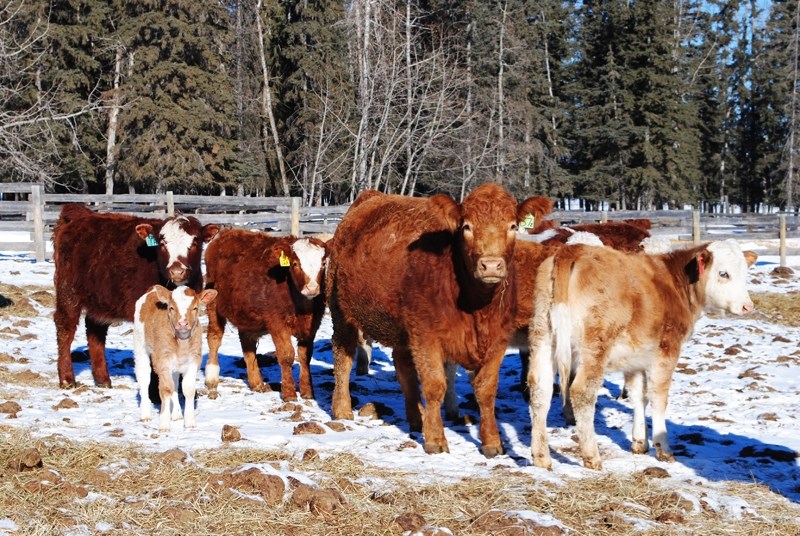With calving season underway, and bitter winter temperatures continuing to plague the region, ranchers are being reminded to take precautionary steps to make sure newborn calves hit the ground running.
Longtime area farmer Nola Bowhay, who owns a farm with her husband Jim in Bergen, said she has found that it is ideal to have straw beds for cattle to lie on.
Having a barn or some kind of shelter available in extreme temperatures is essential, she said.
“If it's 30 below you're going to have to bring your calves in because they will freeze their ears and tails,” Bowhay said during a tour of the farm on Feb. 26.
“So you bring them into the barn or some people just have a hot box. They will stick them in a box that has warm air or light or something just to warm and dry them.
“Once they dry, they're pretty hearty. You can put them back out pretty quickly.”
It is crucial for a calf to have milk in the first 12 hours after birth, she noted.
“What's very crucial is to make sure that those calves have sucked or have gotten colostrum if they're not up to suck,” she said. “They need that in the first 12 hours. That's what gives them all their mechanisms for disease prevention.”
There is powdered colostrum available in stores, in case the calf doesn't feed from the mother cow right away, she noted.
The farmer doesn't necessarily have to be with the cow when the calf is born. But in extreme temperatures, the calf needs to be checked on every two hours.
She said the calf could die in extreme temperatures or if they don't get any colostrum.
“You want your calf coming two feet and head first. So if they're not, you've got to figure out what's going on and help them out,” she said. “But ideally you don't want to have to help them, you want them to have them on their own.”
Sometimes the calf is born too big. A calf that weights 75-97 pounds is an average sized calf, but if they get to be 100-120 pounds, then birth may be more difficult, she said.
As well, she said twin calves are not easy because sometimes one is weaker.
“There are some cows that can feed twins fine. There's others that just don't have the milk supply and so they're always stealing from others,” she said.
Although calving season began in January for purebred breeders, the Bowhays allow their cattle to breed naturally, which is in May and June.
On average they expect 120 calves on their farm each year, and the calves stay with their mothers for five to six months.
“There's neighbours here that have 300, you know, there's others that have 25. It just depends on the herd size of each individual farmer,” she said.
Extreme temperatures don't have much effect on cattle overall, other than they eat more, she added.
“You just have to feed them a little more,” she said.
The Bowhay family has owned their farm since the '70s. They also have goats and egg-laying chickens.
“It's just a way of life that we really enjoy,” she said. “The birth of new animals is always exciting to see, you know, the growth.”
Tammy Monk, veterinary assistant at Pioneer Vet Services in Sundre, said there are tools that farmers should have handy when entering calving season.
“Make sure that you have the proper stuff. So new gloves, chains, surgical soap, navel dip, proper minerals that they need when they're first born,” explained Monk.
“If you're thinking a cow is going to calve, put them in a barn.”
The survival rate of the calf depends on the mother cow first, she said.
“As long as they're (the mother cow) right up there and right at it they can get their calves up and going and get them dried off. It sounds strange to say that a cow will lick a calf dry but they will,” she said.
“They will get them going, get them up and get them sucking, because once they get that first milk then that kind of gives them the energy that they need to kind of half stay warm.
“The most important part of that calf's survival from hour 1, up to an old animal, is that first milk.”
Heifers tend not to be the best mothers because they don't know what's going on, she said.
“A lot of that is farmer and rancher management as well. You have to be out there checking them and making sure that the calf is in fact up and going and not just kind of chilling out in the straw,” she said.
“The survival rate solely depends on first the cow and then the rancher after that.”
She also said it is important to be extra cautious in extreme temperatures.
“Calves are more susceptible, because obviously they're born out in the cold. They are more susceptible to frozen ears, frozen feet, frozen tail, frozen body parts in general,” she said.
“When it's really cold out they should be checked every couple hours.”



